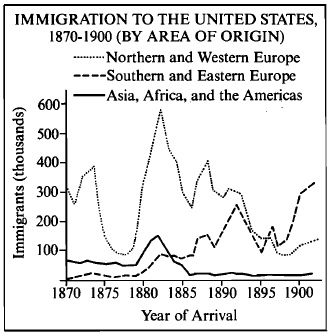Unit 4: Chapters 20-26 Practice
5.0(2)
5.0(2)
Card Sorting
1/26
Earn XP
Study Analytics
Name | Mastery | Learn | Test | Matching | Spaced |
|---|
No study sessions yet.
27 Terms
1
New cards
In the second half of the nineteenth century, the formation of labor unions was often a response to
low wages and dangerous conditions in industrial work
2
New cards

Which of the following best accounts for the curve on the graph above depicting immigration to the United States from Asia, Africa and the Americas between 1882 and 1900?
Restrictive congressional legislation
3
New cards
The belief by some Americans that the Civil War was “a rich man’s war but a poor man’s fight” was reflected in
the draft riots in New York City
4
New cards
The Black Codes passed in a number of southern states after the Civil War were intended to
place limits on the socioeconomic opportunities open to Black people
5
New cards
Which of the following statements about African American soldiers during the Civil War is correct?
For most of the war, they were paid less than White soldiers of equal rank.
6
New cards
Which of the following developments best explains changes in agricultural production in the United States during the 1880s and 1890s?
New systems of transportation integrated farming into national markets.
7
New cards
The Supreme Court decision on *Brown* v. *Board of Education of Topeka* essentially reversed which of the following earlier Court decisions?
*Plessy* v. *Ferguson*
8
New cards
Which of the following pairs of immigrant groups were most prominent in the construction of the first transcontinental railroad?
Chinese and Irish
9
New cards
The most controversial and divisive component of the Compromise of 1850 was the
passage of a tougher national fugitive slave act
10
New cards
**“**Another marked characteristic of the Anglo-Saxon is what may be called an instinct or genius for colonizing. His unequaled energy, his indomitable perseverance, and his personal independence, made him a pioneer. He excels all others in pushing his way into new countries.**”**
\
Americans advocating the ideas expressed in the passage above would be most accurately described as
\
Americans advocating the ideas expressed in the passage above would be most accurately described as
Social Darwinists
11
New cards
“It is for us the living, rather, to be dedicated here to the unfinished work which they who fought here have thus far so nobly advanced. It is rather for us to be here dedicated to the great task remaining before us—that from these honored dead we take increased devotion to that cause for which they gave the last full measure of devotion—that we here highly resolve that these dead shall not have died in vain—that this nation, under God, shall have a new birth of freedom—and that government of the people, by the people, for the people, shall not perish from the earth.”
Abraham Lincoln, Gettysburg Address, November 1863
Question
\
After 1863, which of the following most fulfilled the “new birth of freedom” that the excerpt refers to?
Abraham Lincoln, Gettysburg Address, November 1863
Question
\
After 1863, which of the following most fulfilled the “new birth of freedom” that the excerpt refers to?
Ratification of the Thirteenth, Fourteenth, and Fifteenth Amendments
12
New cards
In the 1850’s, the South differed from the North in that the South had
fewer European immigrants
13
New cards
In 1861 the North went to war with the South primarily to
preserve the Union
14
New cards
In the late nineteenth century, state governments in the South were largely successful in restricting
African Americans’ voting rights guaranteed by the Fifteenth Amendment
15
New cards
Which of the following was LEAST involved in the struggle for women’s rights?
Dorothea Dix
16
New cards
Progressive reformers rejected Social Darwinism because they believed that
conflict and competition did not necessarily improve society
17
New cards
Which of the following was a consequence of the shift to sharecropping and the crop lien system in the late nineteenth-century South?
A cycle of debt and depression for Southern tenant farmers
18
New cards
Although the Sherman Antitrust Act was originally intended to inhibit the growth of business monopolies, courts initially used its provisions successfully against
labor unions
19
New cards
Which of the following was true of the 1873 Slaughterhouse Cases and the 1883 Civil Rights cases?
They weakened the protections given to African Americans under the Fourteenth Amendment.
20
New cards
All of the following contributed to Northern fear of a slave power conspiracy in the 1840s and 1850s EXCEPT the
passage of the Wilmot Proviso
21
New cards
On the eve of the Civil War, the South enjoyed an advantage over the North in
experienced military leadership
22
New cards
The Fifteenth Amendment to the United States Constitution established
that suffrage cannot be denied based on race, color, or previous servitude
23
New cards
A key goal of the Progressive movement was to
use government power to regulate industrial production and labor conditions
24
New cards
Constitutional amendments enacted during the Progressive Era concerned all of the following EXCEPT
imposition of poll taxes
25
New cards
The decisions of the Supreme Court in the late nineteenth and early twentieth centuries generally did which of the following?
Strengthened the position of big business.
26
New cards
Which of the following developments best explains the reasons for the growth of a new urban culture in the late 1800s?
International and internal migration increased urban populations and brought diverse people to cities.
27
New cards
After the Civil War, women reformers and former abolitionists were divided over
legislation that ensured the voting rights of African American males